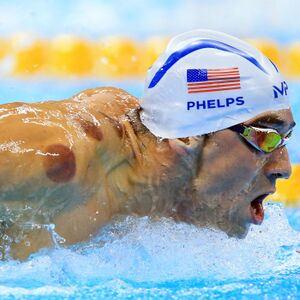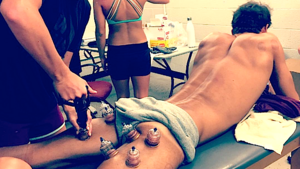Modern Cupping from Clinical Approach
Introduction[edit | edit source]
Cupping Therapy is a universal practice in the East and West[1], where its popularity has been spanned in modern communities when Michael Phelps-Olympic gold medal winner, was seen with cupping marks in Rio de Janeiro in Brazil in 2016[2]. Cupping Therapy is an alternative medicine that is sometimes referred to as suction therapy based on its mechanism of action or Myo-fascial Decompression Therapy[3]. Different types of cupping therapy have been used to treat many diseases with different conditions that include improvement of sports performance[2].
An updated classification of cupping therapy is developed and more types of cupping therapy are categorized, this 6 criteria classification includes [4][5]: Area treated category, the material inside the cups and the sixth category is other cupping types for example sports, cosmetic, and aquatic cupping[5].
Evidence to date:[edit | edit source]
An overview of systematic reviews assessed the safety and effectiveness of cupping therapy for 11 diseases through an evidence-based approach[6]. Results of multiple systematic reviews showed that cupping therapy (alone or combined with other interventions) was better than medications (or other interventions alone) for different diseases including cervical spondylosis and low back pain, although one review reported adverse effects like an increase in pain and tingling after cupping treatment[6]. Overall, Cupping may be beneficial for pain relief[6][7]. On the other note, the insufficient number of reviews and the poor qualities of the original studies couldn't firm the conclusive results[6][8]. A systematic literature search was performed until April 2018 for randomized controlled trials (RCTs) about musculoskeletal pain or reduced range of motion, treated with dry cupping. Outcomes were pain, functional status, range of motion and adverse events. A total of 21 RCTs with 1049 participants were included. Overall, the quality of evidence was fair, with a mean D&B score of 18/28. Low-quality evidence revealed dry cupping had a significant effect on pain reduction for chronic neck pain (MD, -21.67; 95% CI, -36.55, to -6.80) and low back pain (MD, -19.38; 95%CI, -28.09, to -10.66). Moderate-quality evidence suggested that dry cupping improved functional status for chronic neck pain (MD, -4.65; 95%CI, -6.44, to -2.85). For range of motion, low-quality evidence revealed a significant difference when compared to no treatment (SMD, -0.75; 95%CI, -0.75, to -0.32).[9]
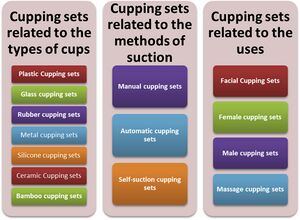
The mechanism of action of cupping therapy was not clear until now [7]. No single theory explains the whole effects of it[10]. Generally speaking it is a low risk treatment, however, cupping has contraindications to be considered[1].
Different types of cupping sets were used in previous studies[4]. In an updated review, studies used dry cupping the most, followed by wet cupping[11]. Most studies compared cupping therapy to non-intervention, other studies compared cupping to standard medical care, heat, routine physiotherapy, electrical stimulation, active range of motion and stretching, passive stretching, or acetaminophen. Treatment duration ranged from 1 day to 12 weeks[11].
The level of evidence of cupping is increasing on soft tissue flexibility up to moderate. Its effect on decreasing low back pain or cervical pain is low to moderate. About treating other musculoskeletal conditions, it is very low to low evidence. Finally, the incidence of adverse events is very low[11].
How to apply modern cupping in sports[edit | edit source]
Benefits in MSK problems[edit | edit source]
Cupping may be an effective tool with low risk in treating nonspecific, musculoskeletal pain like back, and neck pain [8], fibromyalgia[12] and shoulders[7]. This also has been concluded in the results of a further concise review[13].
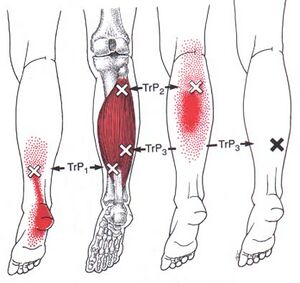
RCT investigated the outcomes of Dry cupping on pain and function for patients with planter heal pain using cups on calf muscle myofascial trigger points (MTrPs)[14]. The research concluded that adding dry cupping on calf MTrPs to self-stretching and ankle dorsiflexion exercises for those patients was superior to only self-stretching and active ankle dorsiflexion exercises, ankle dorsiflexion ROM, and plantar flexor strength[14][15]. Self-stretching was performed with the cup placed on the calf trigger point for 20 seconds followed by 20 seconds of rest for 3 minutes Outcome measures were visual analogue scale (VAS), pressure pain threshold (PPT), and patient-specific functional scale (PSFS). Also, secondary outcomes were ankle dorsiflexion range of motion (ROM) and ankle plantar flexor strength. Results showed improvements in those outcomes when measures were assessed immediately after the session and after 2 days[14][16]. Future research is still recommended to address the long-term efficacy of this technique as the absence of a placebo group in this RCT is considered one of the study limitations[17]. However, definitive conclusions regarding the effectiveness and safety of dry cupping for musculoskeletal pain and range of motion were unable to be made due to the low-moderate quality of evidence.[9]
The same idea can be applied for planter foot pain of neural origin by adding neural glides of the lower quarter and the cupping is placed in the saphenous nerve course as reported in 65-year-old case study[18].
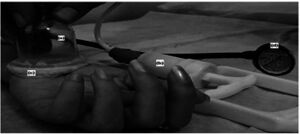
Cupping therapy has therapeutic effects in the treatment of Carpal Tunnel Syndrome[19][20]. Studies that support cupping effects on CTS have been growing over the past decade[21]. The treatment was safe and tolerable when Cupping was applied on related shoulder zones that appeared to alleviate the symptoms of carpal tunnel syndrome[19].
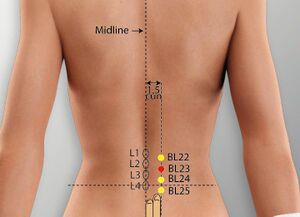
Post-partum low back pain: Comparison between Dry cupping and acupressure at the acupuncture point BL23 was assessed in an RCT using McGill Pain Questionnaire Form[22]. Cupping was applied 15-20 minutes for 4 sessions per week, day on day off basis. It was followed by the acupuncture treatment for 20 minutes on a circular model. Data was gathered immediately, after 24 hours and following 2 weeks. The results showed pain relief effects for the two modalities[22].
Knee osteoarthritis: Dry cupping therapy combined with Western medicine therapy was more effective than Western therapy alone in reducing the pain of knee osteoarthritis[23]. Still, the concluded hypothesis that supported the effects of cupping in the physical function of patients with knee OA is weak [24][23].
Migraines: Wet cupping has shown evidence in the reduction of pain and disability in patients with migraine, and the efficacy proved to be increased when the treatment (once a month for 3 months) continued[25].
Benefits on the Lymphatic system[edit | edit source]
Proposed mechanisms of action have suggested the effects of sub-atmospheric pressure suction, promoting peripheral blood circulation, and improving immunity[26]. Overall, the activation of the immune system by cupping might explain its various effects including therapeutic outcomes in patients with autoimmune diseases[27].
Cancer patient: A recent prospective observational study assessed the outcomes of moving cupping on side effects of chemo-therapy for people with CRC (Colorectal Cancer)[28]. The study was conducted for patients who were diagnosed with CRC and were being treated for their chemotherapy side effects. They received 3 sessions per week for consecutive 10 weeks and their quality of life was assessed after 3 months. Results concluded that moving cupping treatment programs relieved some side effects and symptoms and improved those patients' quality of life like physical function, fatigue, pain and sleep disturbance[28] [29].
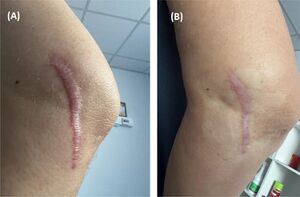
Scars management: Cupping is a supportive method used in scar treatment in the remodeling phase of wound healing, however too much pressure can induce micro-traumatic injuries and trigger new inflammation cycles[4][30].
The treatment protocol of combined therapies for 30 minutes per week for 8 weeks, therapies included (scar manipulation, massage, cupping, tapping and dry needling whereas cupping and dry needling started in the 5th week and cupping was used 4 times in the whole program. The treatment has significant improvement in skin parameters, scar thickness and pain[30].
Lymphoedema management: Negative pressure, is a new means of offering treatment, whereby a pulling or opening force is applied to the tissues[31]. This was hypothesized due to the evidence of patients who experienced secondary tissue changes post-liposuction despite the conservative lymphatic therapy. Then new technology was invented to be used as an adjunct to massage and manual lymphatic drainage and as an example of a negative pressure massage device[31].
Benefits in sports performance[edit | edit source]
When reporting on the use of cupping among elite athletes, the National Broadcasting Company stated that cupping is a “therapy technique that athletes use to help their muscles recover and perform at their best[32]. Cupping is used for sports injuries such as congestion, swelling and spasms. Additionally, it plays a role as an analgesic and elimination of the cause of injury [33]. Professional and amateur athletes of different sports applied cupping between 1 and 20 times, on daily and or weekly basis alone or combined with treatment. Cupping has recovery and functional measures on athletes and is regarded as beneficial for pain, increased range of motion and creatine kinase. However no direct recommendation with or against using it for athletes[34]
Hamstring Pathology: Immediate effects of cupping therapy on hamstring mild strain, tightness and decreased flexibility; compared to that of self myofascial release were evaluated through a pilot randomized trial[35]. Patients of one group received 3 minutes of static treatment of 6 plastic-valve suction cups along the hamstrings muscles, followed by 20 repetitions of active movement with cups remained in place[35]. The other group received 10 minutes of heat treatment over the hamstrings followed by 60 seconds of hamstring muscle mobilization, and 90 seconds of targeted foam rolling on the area of most perceived tightness. Outcome measures included passive hamstring flexibility ROM and Perceived Functional Ability Questionnaire (PFAQ) that were recorded before and after the treatment session. Global Rating of Change measure (GROC) was measured after the session. Both treatment were beneficial but study favored the MFD group for the better scores resulted in the GROC measures[35].
However, further updated critical appraisal concluded that there's no enough high evidence that supports the use of MFD to increase hamstring flexibility and it's only level B evidence that supported the effectiveness of cupping at increasing the hamstring flexibility[36]. Similar results were reported on a study applied static cups for 10 minutes to test hamstring flexibility afterwards using hip ROM as a measure. It found no difference for the cupping treatment compared to the sham group of the same study on the hip range[37].
Finally, the effect of single session of moving cupping technique to the posterior aspect of the lower limb on the Knee ROM and flexion power was tested. Also patient perception about the treatment was considered[38]. Results showed considerable increase in Hip and Knee Ranges. 7% in SLR, 4% in popliteal angle test but no effects on flexion power, also it showed acceptable perception of the patients on the moving cups[38].
Iliotibial band syndrome: A controlled laboratory study was designed to determine if dry cupping is effective treatment to release ITB tightness through measuring angle of hip adduction (Ober's test)[39]. Findings indicated that single intervention of 4 static cups for 7 minutes along the ITB, is probably effective in reducing ITB tightness and increasing hip range. This was observed 24 hours after the treatment[39] .
Conclusion[edit | edit source]
- Cupping therapy is a widely spread practice among the east and the west that has been recently gained more popularity in the sports communities for athletic purposes[1][4][2].
- Different types of Cupping therapy can be used to help variety of MSK conditions[1][13]. Frequency, number of cups and dose of treatment depend on the body area, type and method of cupping that has been used.
- Combination of cupping therapy with other modality is suggested variantly among the literature as an adjunct tool for treating many conditions.[3][30][13].
- Future research could focus on trying to find clear answers for the most likely mechanism of action and to validate the current theories in clinical trials[20], Also basic scientific innovative research is needed to verify the suggested evidence beyond it's action[10].
- Further high-quality trials with larger sample sizes, long-term follow up, and reporting of adverse events are warranted.[9]
References[edit | edit source]
- ↑ 1.0 1.1 1.2 1.3 Zhang H, Zhao M, Wu Z, Wang X, Jiang Y, Liang J, et al. Effects of acupuncture, moxibustion, cupping, and massage on sports injuries: A narrative review. Evid Based Complement Alternat Med [Internet]. 2022 [cited 2023 Apr
- ↑ 2.0 2.1 2.2 Musumeci G. Could cupping therapy be used to improve sports performance?. Journal of Functional Morphology and Kinesiology. 2016 Oct 27;1(4):373-7.
- ↑ 3.0 3.1 Warren AJ, LaCross Z, Volberding JL, O’Brien MS. Acute outcomes of myofascial decompression (cupping therapy) compared to self-myofascial release on hamstring pathology after a single treatment. Int J Sports Phys Ther [Internet]. 2020;15(4):579–92.
- ↑ 4.0 4.1 4.2 4.3 Aboushanab TS, AlSanad S. Cupping therapy: an overview from a modern medicine perspective. Journal of acupuncture and meridian studies. 2018 Jun 1;11(3):83-7.
- ↑ 5.0 5.1 Al-Bedah AM, Aboushanab TS, Alqaed MS, Qureshi NA, Suhaibani I, Ibrahim G, Khalil M. Classification of cupping therapy: a tool for modernization and standardizaJournal of Complementary and Alternative Medical Research.tion. 2016 Jun;1(1):1-0.
- ↑ 6.0 6.1 6.2 6.3 Cao H, Han M, Zhu X, Liu J. An overview of systematic reviews of clinical evidence for cupping therapy. Journal of Traditional Chinese Medical Sciences. 2015 Jan 1;2(1):3-10.
- ↑ 7.0 7.1 7.2 Cao H, Li X, Liu J. An updated review of the efficacy of cupping therapy. PloS one. 2012 Feb 28;7(2):e31793.
- ↑ 8.0 8.1 Cao H, Li X, Yan X, Wang NS, Bensoussan A, Liu J. Cupping therapy for acute and chronic pain management: a systematic review of randomized clinical trials. Journal of Traditional Chinese Medical Sciences. 2014 Jul 1;1(1):49-61.
- ↑ 9.0 9.1 9.2 Wood S, Fryer G, Tan LLF, Cleary C. Dry cupping for musculoskeletal pain and range of motion: A systematic review and meta-analysis. J Bodyw Mov Ther. 2020 Oct;24(4):503-518. doi: 10.1016/j.jbmt.2020.06.024. Epub 2020 Jul 30. PMID: 33218554.
- ↑ 10.0 10.1 Al-Bedah AM, Elsubai IS, Qureshi NA, Aboushanab TS, Ali GI, El-Olemy AT, Khalil AA, Khalil MK, Alqaed MS. The medical perspective of cupping therapy: Effects and mechanisms of action. Journal of traditional and complementary medicine. 2019 Apr 1;9(2):90-7.
- ↑ 11.0 11.1 11.2 Mohamed AA, Zhang X, Jan YK. Evidence-based and adverse-effects analyses of cupping therapy in musculoskeletal and sports rehabilitation: A systematic and evidence-based review. Journal of Back and Musculoskeletal Rehabilitation. 2023 Jan 1;36(1):3-19.
- ↑ H. Cao, H. Hu, B. Colagiuri, J. Liu Medicinal cupping therapy in 30 patients with fibromyalgia: a case series observation Forsch Komplementmed, 18 (2011), pp. 122-126
- ↑ 13.0 13.1 13.2 Trofa DP, Obana KK, Herndon CL, Noticewala MS, Parisien RL, Popkin CA, Ahmad CS. The evidence for common nonsurgical modalities in sports medicine, Part 2: Cupping and blood flow restriction. JAAOS Global Research & Reviews. 2020 Jan;4(1).
- ↑ 14.0 14.1 14.2 AlKhadhrawi N, Alshami A. Effects of myofascial trigger point dry cupping on pain and function in patients with plantar heel pain: A randomized controlled trial. Journal of bodywork and movement therapies. 2019 Jul 1;23(3):532-8.
- ↑ Renan-Ordine, R., Alburquerque-SendÍn, F., Rodrigues De Souza, D.P., Cleland, J.A. and Fernández-De-Las-Penas, C., 2011. Effectiveness of myofascial trigger point manual therapy combined with a self-stretching protocol for the management of plantar heel pain: a randomized controlled trial. Journal of orthopaedic & sports physical therapy, 41(2), pp.43-50.
- ↑ Emerich M, Braeunig M, Clement HW, Lüdtke R, Huber R. Mode of action of cupping—local metabolism and pain thresholds in neck pain patients and healthy subjects. Complementary therapies in medicine. 2014 Feb 1;22(1):148-58.
- ↑ Lee MS, Kim JI, Kong JC, Lee DH, Shin BC. Developing and validating a sham cupping device. Acupuncture in Medicine. 2010 Dec;28(4):200-4.
- ↑ Holme JB, Skajaa K, Holme K. Incidence of lesions of the saphenous nerve after partial or complete stripping of the long saphenous vein. Acta chirurgica scandinavica. 1990 Feb 1;156(2):145-8.
- ↑ 19.0 19.1 Michalsen A, Bock S, Lüdtke R, Rampp T, Baecker M, Bachmann J, Langhorst J, Musial F, Dobos GJ. Effects of traditional cupping therapy in patients with carpal tunnel syndrome: a randomized controlled trial. The journal of pain. 2009 Jun 1;10(6):601-8.
- ↑ 20.0 20.1 Al-Shidhani A, Al-Mahrezi A. The role of cupping therapy in pain management: A literature review. Pain Management-Practices, Novel Therapies and Bioactives. 2020 Sep 25.
- ↑ Farhat A, Mughal SM. Is There a Role of Cupping Therapy in the Treatment of Carpal Tunnel Syndrome in Primary Care Setting?. Cureus. 2021 Jan 28;13(1).
- ↑ 22.0 22.1 Yazdanpanahi Z, Ghaemmaghami M, Akbarzadeh M, Zare N, Azisi A. Comparison of the effects of dry cupping and acupressure at acupuncture point (BL23) on the women with postpartum low back pain (PLBP) based on short form McGill pain questionnaires in Iran: a randomized controlled trial. Journal of family & reproductive health. 2017 Jun;11(2):82.
- ↑ 23.0 23.1 Wang YL, An CM, Song S, Lei FL, Wang Y. Cupping therapy for knee osteoarthritis: a synthesis of evidence. Complementary medicine research. 2018;25(4):249-55.
- ↑ Song GM, Tian X, Jin YH, Deng YH, Zhang H, Pang XL, Zhou JG. Moxibustion is an alternative in treating knee osteoarthritis: the evidence from systematic review and meta-analysis. Medicine. 2016 Feb;95(6).
- ↑ Ersoy S, Benli AR. Continue or stop applying wet cupping therapy (al-hijamah) in migraine headache: A randomized controlled trial. Complementary therapies in clinical practice. 2020 Feb 1;38:101065.
- ↑ Zeng K, Wang JW. Clinical application and research progress of cupping therapy. Journal of Acupuncture and Tuina Science. 2016;4(14):300-4.
- ↑ Al-Bedah AM, Elsubai IS, Qureshi NA, Aboushanab TS, Ali GI, El-Olemy AT, Khalil AA, Khalil MK, Alqaed MS. The medical perspective of cupping therapy: Effects and mechanisms of action. Journal of traditional and complementary medicine. 2019 Apr 1;9(2):90-7.
- ↑ 28.0 28.1 Liu YW, Su YL, Chang CL, Tsai MY. Cupping Therapy as an Adjunctive Therapy for Side Effects of Colorectal Cancer Treatment: A Prospective Observational Study. Journal of Chiropractic Medicine. 2022 Dec 1;21(4):280-7.
- ↑ Guo HR, Zhang QY, Li X, Chen Y, Li MY, Zhuo XM, Wang MJ, Shan K, Gong YN, Li NC, Chen B. The effectiveness of cupping therapy on chronic fatigue syndrome: A single-blind randomized controlled trial. Complementary Therapies in Clinical Practice. 2020 Aug 1;40:101210.
- ↑ 30.0 30.1 30.2 Lubczyńska A, Garncarczyk A, Wcisło‐Dziadecka D. Effectiveness of various methods of manual scar therapy. Skin Research and Technology. 2023 Mar;29(3):e13272.
- ↑ 31.0 31.1 Gott FH, Ly K, Piller N, Mangion A. Negative pressure therapy in the management of lymphoedema. Journal of Lymphoedema. 2018 Jun 6;13(1).
- ↑ Olympics NB. Why does Michael Phelps have purple spots on his back.
- ↑ Nasb M, Qun X, Ruckmal Withanage C, Lingfeng X, Hong C. Dry cupping, ischemic compression, or their combination for the treatment of trigger points: a pilot randomized trial. The Journal of Alternative and Complementary Medicine. 2020 Jan 1;26(1):44-50.
- ↑ Bridgett R, Klose P, Duffield R, Mydock S, Lauche R. Effects of cupping therapy in amateur and professional athletes: systematic review of randomized controlled trials. The Journal of Alternative and Complementary Medicine. 2018 Mar 1;24(3):208-19.
- ↑ 35.0 35.1 35.2 Warren AJ, LaCross Z, Volberding JL, O’Brien MS. Acute outcomes of myofascial decompression (cupping therapy) compared to self-myofascial release on hamstring pathology after a single treatment. International Journal of Sports Physical Therapy. 2020 Aug;15(4):579.
- ↑ 2.Spellman J, Eldredge R, Nelson M, Ostrowski J, Concannon J. Is myofascial decompression effective at increasing hamstring flexibility in the athletic population? A critically Appraised topic. J Sport Rehabil [Internet]. 2022 [cited 2023 Apr 29];31(8):1100–4. Available from: https://pubmed.ncbi.nlm.nih.gov/35940580/
- ↑ Schafer MD, Tom JC, Girouard TJ, Navalta JW, Turner CL, Radzak KN. Cupping therapy does not influence healthy adult’s hamstring range of motion compared to control or sham conditions. International Journal of Exercise Science. 2020;13(3):216.
- ↑ 38.0 38.1 Murray D, Clarkson C. Effects of moving cupping therapy on hip and knee range of movement and knee flexion power: a preliminary investigation. Journal of Manual & Manipulative Therapy. 2019 Oct 20;27(5):287-94.
- ↑ 39.0 39.1 Biehl MM. The Therapeutic Effects Of Dry Cupping On Iliotibial Band Tightness. Illinois State University; 2017.
